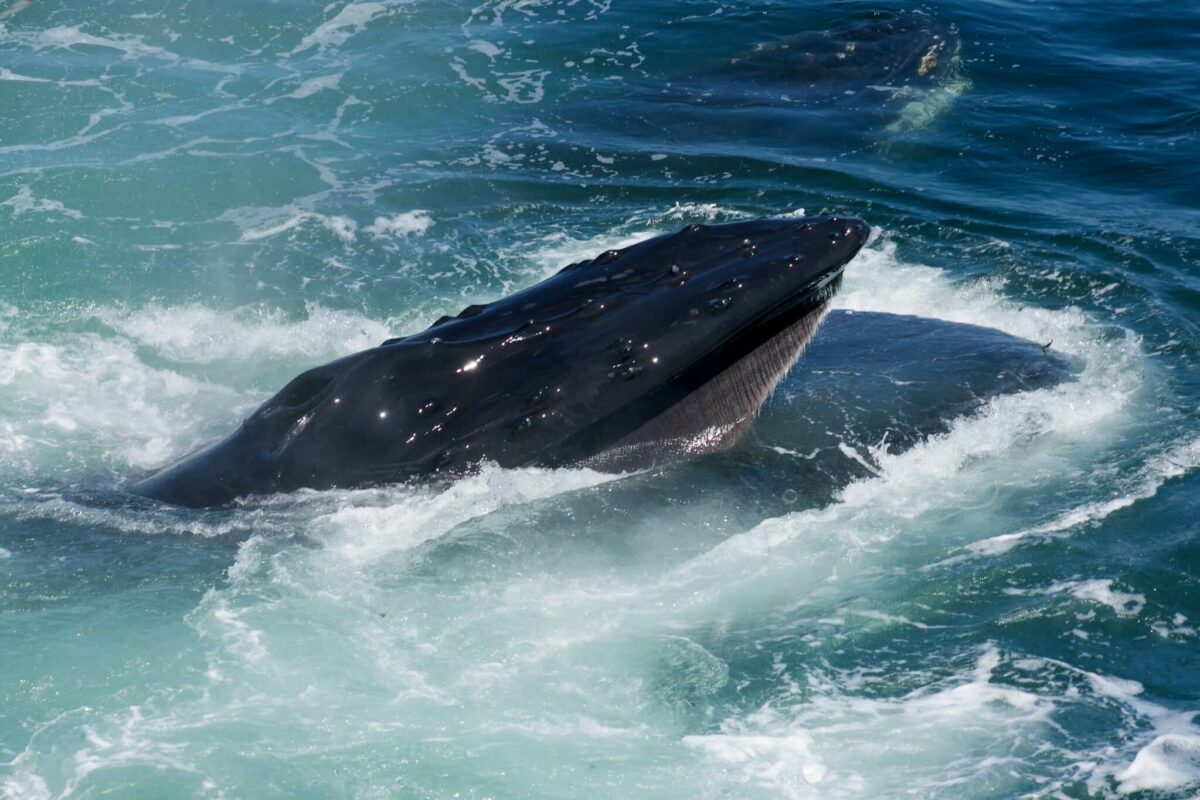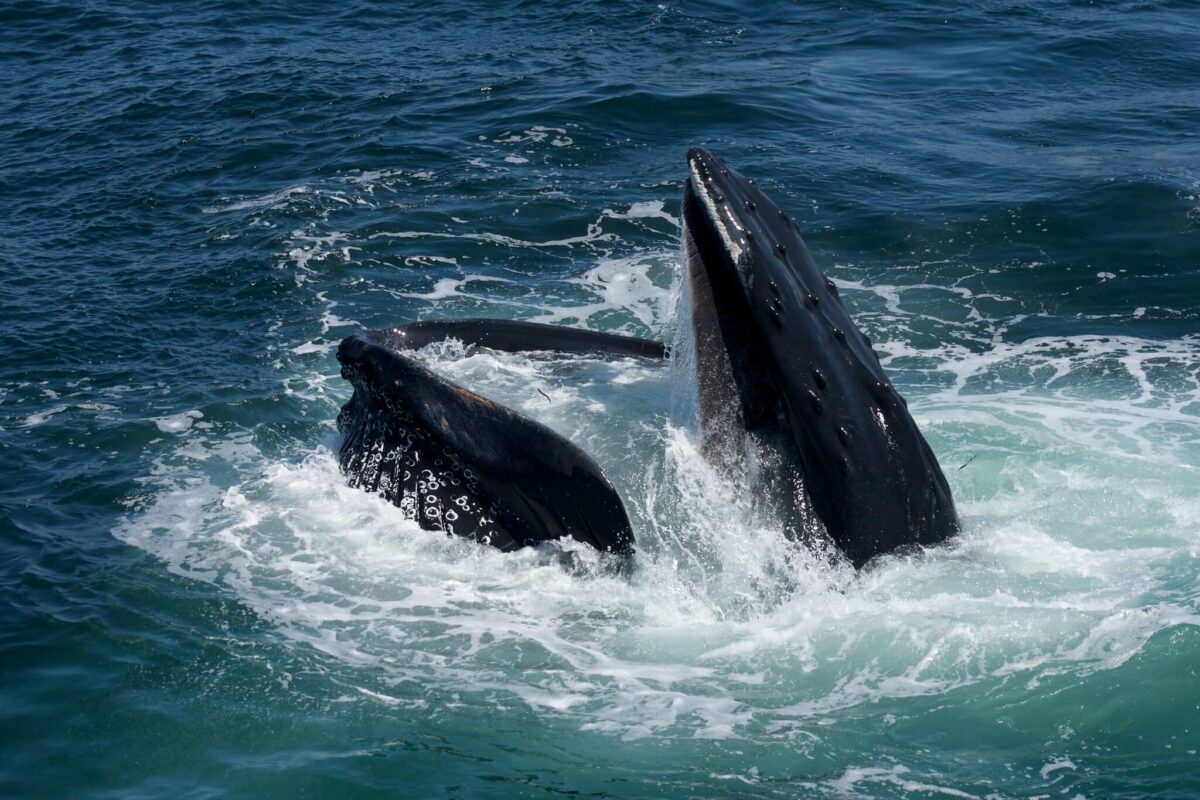Whales are without question some of the most interesting animals in the oceans, they have gripped human imagination for centuries due to their large size and mystery.
They are found in every ocean around the world and are some of the largest animals to EVER roam planet earth, so it’s no surprise we have a fascination with them.
One question that often comes up when discussing these mysterious ocean giants is do whales have teeth?
It’s a bit of a complicated topic and the answer varies depending on which whale species you’re asking about.
That’s why in this post, we’re going to go through everything you need to know about whale teeth and answer this common question.
Let’s get into it…
Do Whales Have Teeth?
Yes, whales do have teeth, BUT, some do not! Some whales have large teeth that they use to catch and eat prey, whilst others don’t have teeth and instead have baleen.
The number of teeth a whale has depends on the species, its diet, as well as its feeding behavior.

Whales that feed on prey such as giant squid, seals, stingrays, and other hearty prey require teeth to catch and consume their food.
Whereas, whales that feed on smaller prey such as krill and plankton have baleen instead, which allows them to sieve out these small critters without the need for large teeth.
Do All Whales Have Teeth?
No, not all whales have teeth. Some whales have specialized adaptations, such as baleen plates which allow them to filter feed on small prey such as krill and plankton.
Baleen is made from keratin which is the same material that makes up human hair and nails and is located in the whale’s upper jaw.
Humpback whales, gray whales, blue whales, and another 11 whale species are categorized as baleen whales by their baleen plates.
Other whales, known as toothed whales have teeth that vary in shape and size depending on their diet and behavior.
This allows them to catch and eat prey of varying sizes, for example, orcas have large three-inch-long teeth that interlock and allow them to shred through many types of prey.
Toothed Whales & Baleen Whales
Toothed whales and baleen whales are two distinct groups of whales that have evolved different feeding strategies over millions of years.
Whilst these are both groups of whales, they differ in their diets, behaviors, and TEETH.
Toothed Whales
Toothed whales are a group of whales that you guessed it…have teeth.
They are a parvorder of cetaceans that includes dolphins, porpoises, and all other whales that possess teeth.
In total, there are 77 toothed whale species that are grouped into ten different families, with some species having only one or two teeth and others having 240 teeth or more.
Toothed whales are generally smaller than baleen whales, and they often have a more streamlined body shape that allows them to swim faster to chase down prey.
They are highly intelligent whales that often work together to take down prey much larger than themselves.
Below are some of the most common toothed whale species:
- Sperm whales
- Killer whales (orca)
- Cuvier’s beaked whale
- Spade-toothed whale
- Sheperd’s beaked whale
- Dwarf sperm whale
- Strap-toothed whale
Baleen Whales
Baleen whales are the other group of whales that do not have teeth, and instead, have an adaptation known as baleen plates that they use to catch and sieve out prey.
These whales are ENORMOUS and are some of the biggest animals on earth, their jaws are filled with baleen plates that hang down from their upper mandible.
Unlike toothed whales, baleen whales feed on much smaller prey such as krill, plankton, squid, and small fish which they filter out with their baleen plates.
These whales are known for their impressive feeding behaviors which allow them to scoop up TONNES of tiny prey every day.
Baleen whales use methods such as bubble netting and lunge feeding for taking in large volumes of prey and water in a single gulp, before filtering out the water and swallowing the catch.
Below are some of the most common baleen whale species:
- Humpback whales
- Gray whales
- Blue whales
- Sei whales
- Bowhead whales
- Fin whales
- North Atlantic right whales
- Minke whales
Are Whales Toothless?
Yes, some whales are toothless. These are the whales that belong to the baleen whale family and have baleen plates instead of teeth.
These whales don’t need teeth to catch prey, and instead have a unique adaptation known as baleen plates to catch and sieve out large quantities of prey at a time.
Baleen whales don’t feed on prey that requires teeth to catch and kill, unlike toothed whales that generally feed on larger prey that require teeth.
So whilst baleen whales don’t have teeth, toothed whales are armed with a set of gnashers that can tear through the thickest of blubber.
More On Whale Teeth
Whales possess a varying number of teeth depending on their diet, with baleen whales not having teeth at all and toothed whales having a number of teeth.
Orca for example have a set of sharp, conical teeth that they use to catch and rip their prey to pieces before consuming it.
These toothed whales feed on over 140 different prey species so they need teeth to be able to hunt.
Sperm whales on the other hand have teeth on their long, narrow jaw which allows them to slurp up their favorite snack…giant squid.

These whales have the largest teeth of any whale which can grow up to an impressive 8 inches (20cm) in length.
As a whole, the type of teeth a whale has will depend on the species as well as the whale’s diet and preferences.
Wrapping Up
In summary, not all whales have teeth as they have evolved to have different adaptations that are more efficient for the type of prey they eat.
Whilst toothed whales do have teeth that vary depending on their diet, baleen whales don’t and instead have baleen plates that they use to sieve out their prey.
With over 40 different whale species that vary in size, diet, and behaviors, many have different adaptations that allow them to successfully hunt prey of varying sizes.
Thanks for taking the time to read this post today and learn more about whale teeth.
Feel free to stick around and learn more about the fascinating world of whales and the many other types of marine wildlife that we discuss here.

Hi, I’m George – the founder of MarinePatch. I created this blog as marine wildlife has been my passion for many years. I’ve spent over a decade in the marine wildlife industry and spent years out in the field conducting research. In today’s modern world, an online blog is the best place for me to share my findings and reach as many people as possible to help educate and inspire others. Enjoy your time here and you’re welcome back anytime!

